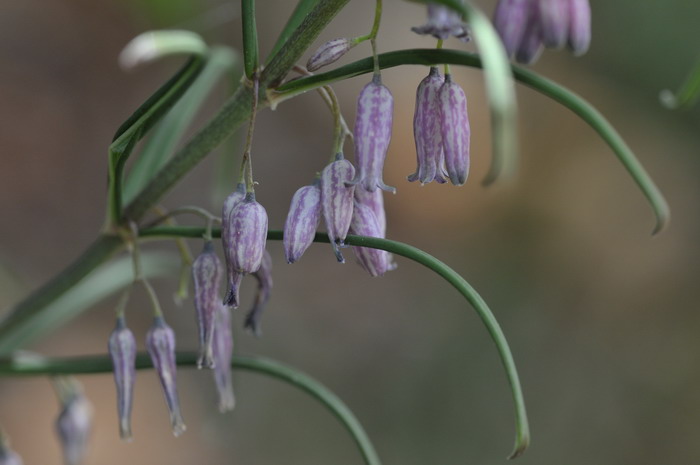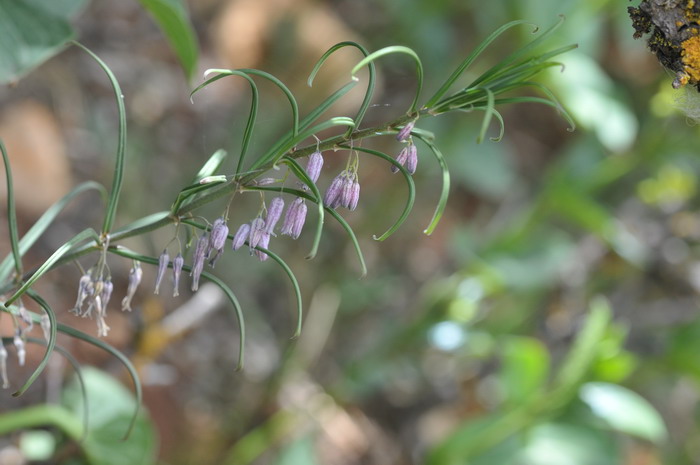卷叶黄精Polygonatum cirrhifolium
中文名(Chinese Name):卷叶黄精
学名(Scientific Name): Polygonatum cirrhifolium (Wall.) Royle
英文名(English Common Name):
别名(Chinese Common Name):滇钩吻
异名(Synonym):Convallaria cirrhifolia Wall. Polygonatum lebrunii H. Lév. Polygonatum souliei Hua Polygonatum cirrhifoliodes D. M. Liu et W. Z. Zeng Polygonatum strumulosum D. M. Liu et W. Z. Zeng Polygonatum fargesii Hua Polygonatum bulbosum H. Lév. Polygonatum trinerve Hua Polygonatum fuscum Hua Convallaria cirrhosa Griff.
科属(Family & Genus):百合科(Liliaceae)黄精属
形态特征(Description):根状茎肥厚,圆柱状,直径1-1.5厘米,或根状茎连珠状,结节直径1-2厘米。茎高30-90厘米。叶通常每3-6枚轮生,很少下部有少数散生的,细条形至条状披针形,少有矩圆状披针形,长4-9(-12)厘米,宽2-8(15)毫米,先端拳卷或弯曲成钩状,边常外卷。花序轮生,通常具2花,总花梗长3-10毫米,花梗长3-8毫米,俯垂;苞片透明膜质,无脉,长1-2毫米,位于花梗上或基部,或苞片不存在;花被淡紫色,全长8-11毫米,花被筒中部稍缢狭,裂片长约2毫米;花丝长约0.8毫米,花药长2-2.5毫米;子房长约2.5毫米,花柱长约2毫米。浆果红色或紫红色,直径8-9毫米,具4-9颗种子。花期5-7月,果期9-10月。
分布(Distribution):产西藏、云南、四川、甘肃、青海、宁夏、陕西。生海拔2000-4000米林下、山坡或草地。尼泊尔和印度也有。
用途(Use):根状茎也作黄精用。
引自植物志英文版:FOC Vol. 24 Page 231
Polygonatum cirrhifolium (Wallich) Royle, Ill. Bot. Himal. Mts. 1: 380. 1839.
卷叶黄精 juan ye huang jing | Liliaceae | Polygonatum
Convallaria cirrhifolia Wallich, Asiat. Res. 13: 382. 1820; Polygonatum bulbosum H. Léveillé; P. cirrhifoliodes D. M. Liu & W. Z. Zeng; P. fargesii Hua; P. fuscum Hua; P. lebrunii H. Léveillé; P. mairei H. Léveillé (1909, not 1912); P. souliei Hua; P. strumulosum D. M. Liu & W. Z. Zeng; P. trinerve Hua.
Rhizome moniliform or tuberous terete, 1--2 cm thick. Stem erect or scandent, 30--90 cm, glabrous. Leaves in whorls of 3--6, rarely also a few alternate in proximal part of stem, sessile, narrowly linear to linear-lanceolate, very rarely oblong-lanceolate, 4--9(--12) cm × 2--8(--15) mm, apex usually cirrose at anthesis. Inflorescences usually 2-flowered; peduncle 3--10 mm; bracts 1--2 mm, scarious, veinless, or bract absent. Flowers pendulous; pedicel 3--8 mm. Perianth white, greenish, or pale purple, subcylindric, slightly constricted in middle, 8--11 mm; lobes ca. 2 mm. Filaments 0.6--0.8 × ca. 0.15 mm, papillose; anthers 2--2.5 mm. Ovary ca. 2.5 mm. Style ca. 2 mm. Berries red or purple-red, 8--9 mm in diam., 4--9-seeded. Fl. May--Jul, fr. Sep--Oct. 2 n = (20*, 24*), 30* (38).
Forests, grassy slopes; 2000--4000 m. Gansu, Guangxi, Ningxia, Qinghai, Shaanxi, Sichuan, Xizang, Yunnan [Bhutan, India, Nepal, Sikkim].
Rudolf Kamelin (pers. comm.) believes that both Polygonatum fargesii and P. fuscum differ from P. cirrhifolium: P. fargesii has leaves not cirrose apically, perianth white, and is distributed in Bhutan, China, and Sikkim; P. fuscum has stems 30--35 cm tall, never scandent, leaves not cirrose apically, perianth green (or dark green or brown-green), and is endemic to China. One of us (Tamura) considers that P. cirrhifolium of the present sense may be a species in which different lineages are lumped. However, Chen and Tamura together decided to maintain the present circumscription until sufficient morphological variation data have accumulated.


 (责任编辑:徐晔春)
(责任编辑:徐晔春)
学名(Scientific Name): Polygonatum cirrhifolium (Wall.) Royle
英文名(English Common Name):
别名(Chinese Common Name):滇钩吻
异名(Synonym):Convallaria cirrhifolia Wall. Polygonatum lebrunii H. Lév. Polygonatum souliei Hua Polygonatum cirrhifoliodes D. M. Liu et W. Z. Zeng Polygonatum strumulosum D. M. Liu et W. Z. Zeng Polygonatum fargesii Hua Polygonatum bulbosum H. Lév. Polygonatum trinerve Hua Polygonatum fuscum Hua Convallaria cirrhosa Griff.
科属(Family & Genus):百合科(Liliaceae)黄精属
形态特征(Description):根状茎肥厚,圆柱状,直径1-1.5厘米,或根状茎连珠状,结节直径1-2厘米。茎高30-90厘米。叶通常每3-6枚轮生,很少下部有少数散生的,细条形至条状披针形,少有矩圆状披针形,长4-9(-12)厘米,宽2-8(15)毫米,先端拳卷或弯曲成钩状,边常外卷。花序轮生,通常具2花,总花梗长3-10毫米,花梗长3-8毫米,俯垂;苞片透明膜质,无脉,长1-2毫米,位于花梗上或基部,或苞片不存在;花被淡紫色,全长8-11毫米,花被筒中部稍缢狭,裂片长约2毫米;花丝长约0.8毫米,花药长2-2.5毫米;子房长约2.5毫米,花柱长约2毫米。浆果红色或紫红色,直径8-9毫米,具4-9颗种子。花期5-7月,果期9-10月。
分布(Distribution):产西藏、云南、四川、甘肃、青海、宁夏、陕西。生海拔2000-4000米林下、山坡或草地。尼泊尔和印度也有。
用途(Use):根状茎也作黄精用。
引自植物志英文版:FOC Vol. 24 Page 231
Polygonatum cirrhifolium (Wallich) Royle, Ill. Bot. Himal. Mts. 1: 380. 1839.
卷叶黄精 juan ye huang jing | Liliaceae | Polygonatum
Convallaria cirrhifolia Wallich, Asiat. Res. 13: 382. 1820; Polygonatum bulbosum H. Léveillé; P. cirrhifoliodes D. M. Liu & W. Z. Zeng; P. fargesii Hua; P. fuscum Hua; P. lebrunii H. Léveillé; P. mairei H. Léveillé (1909, not 1912); P. souliei Hua; P. strumulosum D. M. Liu & W. Z. Zeng; P. trinerve Hua.
Rhizome moniliform or tuberous terete, 1--2 cm thick. Stem erect or scandent, 30--90 cm, glabrous. Leaves in whorls of 3--6, rarely also a few alternate in proximal part of stem, sessile, narrowly linear to linear-lanceolate, very rarely oblong-lanceolate, 4--9(--12) cm × 2--8(--15) mm, apex usually cirrose at anthesis. Inflorescences usually 2-flowered; peduncle 3--10 mm; bracts 1--2 mm, scarious, veinless, or bract absent. Flowers pendulous; pedicel 3--8 mm. Perianth white, greenish, or pale purple, subcylindric, slightly constricted in middle, 8--11 mm; lobes ca. 2 mm. Filaments 0.6--0.8 × ca. 0.15 mm, papillose; anthers 2--2.5 mm. Ovary ca. 2.5 mm. Style ca. 2 mm. Berries red or purple-red, 8--9 mm in diam., 4--9-seeded. Fl. May--Jul, fr. Sep--Oct. 2 n = (20*, 24*), 30* (38).
Forests, grassy slopes; 2000--4000 m. Gansu, Guangxi, Ningxia, Qinghai, Shaanxi, Sichuan, Xizang, Yunnan [Bhutan, India, Nepal, Sikkim].
Rudolf Kamelin (pers. comm.) believes that both Polygonatum fargesii and P. fuscum differ from P. cirrhifolium: P. fargesii has leaves not cirrose apically, perianth white, and is distributed in Bhutan, China, and Sikkim; P. fuscum has stems 30--35 cm tall, never scandent, leaves not cirrose apically, perianth green (or dark green or brown-green), and is endemic to China. One of us (Tamura) considers that P. cirrhifolium of the present sense may be a species in which different lineages are lumped. However, Chen and Tamura together decided to maintain the present circumscription until sufficient morphological variation data have accumulated.
踩一下[1]

顶一下[2]